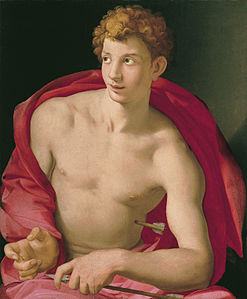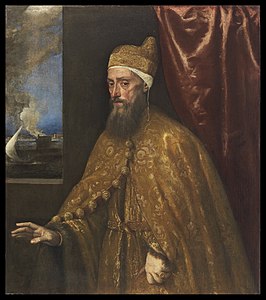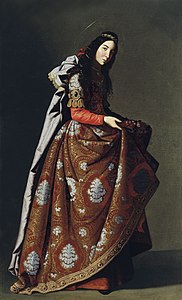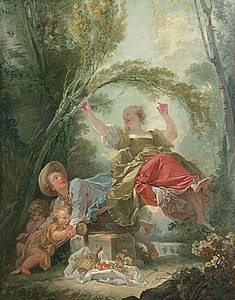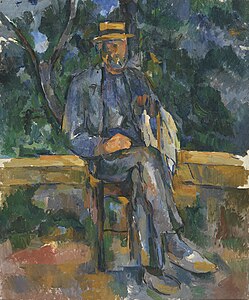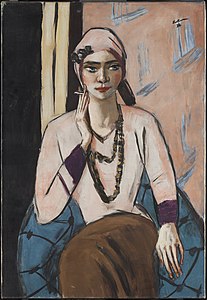
Hans Heinrich August Gábor Tasso Thyssen-Bornemisza de Kászon, Baron Thyssen-Bornemisza, was a Dutch-born Swiss industrialist and art collector. A member of the Thyssen family, he had a Hungarian title and was heir to a German fortune.

Hans Memling was a German-Flemish painter who worked in the tradition of Early Netherlandish painting. Born in the Middle Rhine region, he probably spent his childhood in Mainz. During his apprenticeship as a painter he moved to the Netherlands and spent time in the Brussels workshop of Rogier van der Weyden. In 1465 he was made a citizen of Bruges, where he became one of the leading artists and the master of a large workshop. A tax document from 1480 lists him among the wealthiest citizens. Memling's religious works often incorporated donor portraits of the clergymen, aristocrats, and burghers who were his patrons. These portraits built upon the styles which Memling learned in his youth.

The Museo del Prado, officially known as Museo Nacional del Prado, is the main Spanish national art museum, located in central Madrid. It houses collections of European art, dating from the 12th century to the early 20th century, based on the former Spanish royal collection, and the single best collection of Spanish art. Founded as a museum of paintings and sculpture in 1819, it also contains important collections of other types of works. The numerous works by Francisco Goya, the single most extensively represented artist, as well as by Hieronymus Bosch, El Greco, Peter Paul Rubens, Titian, and Diego Velázquez, are some of the highlights of the collection. Velázquez and his keen eye and sensibility were also responsible for bringing much of the museum's fine collection of Italian masters to Spain, now one of the largest outside of Italy.

Paris Bordone was an Italian painter of the Venetian Renaissance who, despite training with Titian, maintained a strand of Mannerist complexity and provincial vigor.

Petrus Christus was an Early Netherlandish painter active in Bruges from 1444, where, along with Hans Memling, he became the leading painter after the death of Jan van Eyck. He was influenced by van Eyck and Rogier van der Weyden and is noted for his innovations with linear perspective and a meticulous technique which seems derived from miniatures and manuscript illumination. Today, some 30 works are confidently attributed to him. The best known include the Portrait of a Carthusian (1446) and Portrait of a Young Girl ; both are highly innovative in the presentation of the figure against detailed, rather than flat, backgrounds.

Jan Provoost, or Jean Provost, or Jan Provost was a Belgian painter born in Mons.
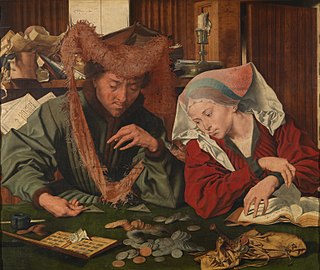
Marinus van Reymerswaele or Marinus van Reymerswale was a Dutch Renaissance painter mainly known for his genre scenes and religious compositions. After studying in Leuven and training and working as an artist in Antwerp, he returned later to work in his native Northern Netherlands. He operated a large workshop which produced many versions of mainly four themes: the tax collectors, the money changer and his wife, the calling of Saint Matthew and St. Jerome in his study.

Juan van der Hamen y (Gómez de) León was a Spanish painter, a master of still life paintings, also called bodegones. Prolific and versatile, he painted allegories, landscapes, and large-scale works for churches and convents. Today he is remembered mostly for his still lifes, a genre he popularized in 1620s Madrid.

Young Knight in a Landscape, or Portrait of a Knight, is an oil on canvas painting by the Italian Renaissance artist Vittore Carpaccio, now in the Thyssen-Bornemisza Museum in Madrid. Dated 1510, this is the earliest full-length portrait in Western painting—on the assumption that it is a portrait, as it seems likely. It is characteristic of Carpaccio that apart from this important innovation, the style of the work seems in other respects to look back to the previous century. From some time until the 20th century the painting had been given the monogram of Albrecht Dürer, and Carpaccio's signature had been overpainted. The realism and detail of Carpaccio does in fact show Northern influence.

Hans Maler zu Schwaz (1480/1488–1526/1529) was a German painter born in Ulm and active as portraitist in the village of Schwaz, near Innsbruck. Maler may have trained with the German artist Bartholomäus Zeitblom, who was chief master of the School of Ulm between 1484 and 1517. He painted numerous portraits of members of the Habsburg court at Innsbruck as well as of wealthy merchants such as the Fuggers.

Frances Lasker Brody (1916–2009) was an American arts advocate, collector, and philanthropist who influenced the development of Los Angeles' cultural life as a founding benefactor of the Los Angeles County Museum of Art and later as a guiding patron of the Huntington Library, Art Collections and Gardens.
Frank Richard Perls was a German-born American art dealer who was best known for uncovering a series of fraudulent art works. As an interpreter with the United States Third Army, Perls worked together with Army intelligence officer Martin Dannenberg in April 1945 in the discovery of a copy of the 1935 Nuremberg Laws signed by Adolf Hitler.

María del Carmen Rosario Soledad Cervera y Fernández de la Guerra, Dowager Baroness Thyssen-Bornemisza de Kászon et Impérfalva, popularly known as Carmen "Tita" Cervera or Carmen "Tita" Thyssen, is a Spanish socialite, and art dealer, collector and beauty pageant titleholder.

Carlos Sebastián Pedro Hubert de Haes was a Spanish painter from Belgium. He was noted for the Realism in his landscapes, and was considered to be the "first contemporary Spanish artist able to capture something of a particularly Spanish 'essence' in his work". He was cited along with Jenaro Perez Villaamil and Aureliano de Beruete as one of the three Spanish grand masters of landscape painting, the latter of which was his pupil.

The Carmen Thyssen Museum is an art museum in the Spanish city Málaga. The main focus of the museum is 19th-century Spanish painting, predominantly Andalusian, based on the collection of Carmen Cervera, fifth wife of Baron Hans Heinrich Thyssen-Bornemisza.
Stephen Hahn was an American art dealer and collector. An expert on Picasso, Degas, and others, he held one of the most significant collections of twentieth century masters during his years operating the Stephen Hahn Gallery in New York City.
Gustav Rau was a German medical doctor, philanthropist and art collector. Rau who was born and died in Stuttgart.

Rue Saint-Honoré, dans l'après-midi. Effet de pluie is an 1897 oil painting by Camille Pissarro. The work was made towards the end of Pissarro's career, when he abandoned his experiments with Pointillism and returned to a looser Impressionist style. It is part of a series of works that Pissarro made in 1897–98 from a window of the Grand Hôtel du Louvre, looking down across the edge of the Place du Théâtre Français and along the rue Saint-Honoré, portraying the people, carriages and buildings, the trees, fountains and streetlamps, in an early afternoon shower of rain. Other paintings in the series depict a similar scene in morning sunlight, or in the shadows of the evening. The painting measures 81 cm × 65 cm.
Julius Cassirer was a German Jewish industrialist and art collector and principal shareholder of Kabelwerke Dr. Cassirer & Co. in Berlin. An artwork from his collection is the object of one of the longest-running Holocaust-linked art restitution cases in history.

Portrait of a Young Woman Known as "La Bella" is an oil painting attributed to Palma Vecchio, and dated to around 1518 to 1520, in the collection of the Thyssen-Bornemisza Museum in Madrid. It was formerly attributed to Titian.
















